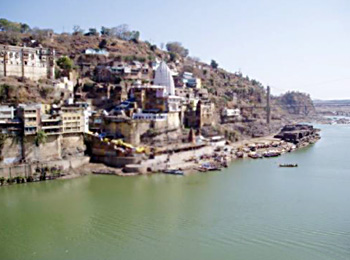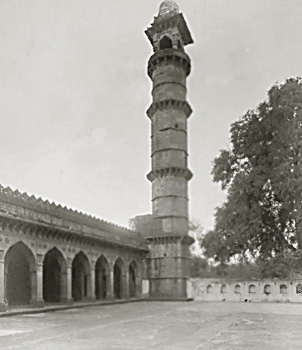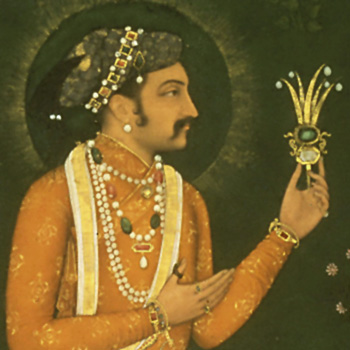 History of Khandwa (East Nimar) district is witness to the rule of several dynasties including the Mauryas, Early Satvahanas, Sungas, Kardamakas, Vakatakas, Abhiras, Imperial Guptas, Paramaras, Vardhanas (of Harsha Vardhana fame), Kalchuris, Chalukyas, Rashtrakutas, Faruki Dynasty, the Mughals, the British, etc. Before the States reorganization, i.e., November 1st, 1956, the district was officially known as Nimar district and formed part of Mahakoshal region of the erstwhile Madhya Pradesh. The western part of old Prant Nimar became a part of Madhya Bharat, when that state was formed in the year 1948. As on the reorganization of States, Madhya Bharat merged in Madhya Pradesh, the western part of old Prant Nimar thus became a part of Madhya Pradesh. This tract with its headquarters at Khargore, retained its old name of Nimar, and being to the west of the district of former Nimar of Mahakoshal region, was named as Nimar (West) or West Nimar, while the district was officially renamed as Nimar (East) or East Nimar from 1st November, 1956. On 15th August, 2003 the district was divided into Khandwa district and Burhanpur district.
History of Khandwa (East Nimar) district is witness to the rule of several dynasties including the Mauryas, Early Satvahanas, Sungas, Kardamakas, Vakatakas, Abhiras, Imperial Guptas, Paramaras, Vardhanas (of Harsha Vardhana fame), Kalchuris, Chalukyas, Rashtrakutas, Faruki Dynasty, the Mughals, the British, etc. Before the States reorganization, i.e., November 1st, 1956, the district was officially known as Nimar district and formed part of Mahakoshal region of the erstwhile Madhya Pradesh. The western part of old Prant Nimar became a part of Madhya Bharat, when that state was formed in the year 1948. As on the reorganization of States, Madhya Bharat merged in Madhya Pradesh, the western part of old Prant Nimar thus became a part of Madhya Pradesh. This tract with its headquarters at Khargore, retained its old name of Nimar, and being to the west of the district of former Nimar of Mahakoshal region, was named as Nimar (West) or West Nimar, while the district was officially renamed as Nimar (East) or East Nimar from 1st November, 1956. On 15th August, 2003 the district was divided into Khandwa district and Burhanpur district.
Ancient History of Khandwa (East Nimar) District
Recent explorations in the beds and tributaries of Narmada River have revealed traces of the Paleolithic men in East Nimar district. Omkar Mandhata, a rocky island on the bank of Narmada River, about 47 miles North-West of Khandwa, is said to have been conquered by the Haihaya King Mahishmant, a scion of Yadu family, who had named the same as Mahishmati. During the rise of Buddhism, the East Nimar region was included in Avanti Kingdom under Chand Pradyota Mahesana, later added to the growing empire of Magadha by Shishunaga. From the early 2nd Century B.C. to late 15th Century A.D., the Nimar Region underwent the rule of several emperors from many dynasties which include Mauryas, Early Satvahanas, Sungas, Kardamakas, Vakatakas, Imperial Guptas, Abhiras, Kalchuris, Chalukyas, Vardhanas (of Harsha Vardhana fame), Rashtrakutas, Faruki Dynasty, Paramara Dynasty, etc.
 Medieval History of Khandwa (East Nimar) District
Medieval History of Khandwa (East Nimar) District
Particularly Khandwa city in the district of this district Khandwa (East Nimar) is not having remarkable history but the nearby Burhanpur district has a glorious past during the Mughal period and the impact of presence of such mighty places is obvious. In 1536 A.D., the Mughal Emperor Humayun, after his conquest of Gujarat, had visited Burhanpur and Asirgarh via Baroda, Broach (Bharuch) and Surat. Raja Ali Khan (1576-1596 A.D.), also known as Adil Shah, was ordered to submit to Akbar, when the latter had sent an expedition to Khandesh, in the summer of 1577 A.D. The former, to avoid the unequal contest with the mighty Akbar, dropped his royal title of Shah and accepted the suzerainty of Akbar. This marked an epoch in the Deccan policy of the Mughals, for Khandesh was used as a base for the future conquest of Deccan. Raja Ali Khan constructed many buildings like Jama Masjid in the upper portion of the fort of Asir in 1588 A.D., Idgah at Asir, Jama Masjid at Burhanpur in 1590 A.D., Mausoleums and Serai at Burhanpur and Serai and Mosque at Zainabad.
Bahadur Khan, successor of Raja Ali Khan declared independence and refused to pay homage to Akbar and his son Prince Daniyal. It enraged Akbar, and he marched towards Burhanpur in 1599 and occupied the city without any opposition on 8th April 1600 A.D. Akbar paid a visit to Asirgarh, so as to inspect it personally, where he stayed for 4 days before returning to his headquarters at Burhanpur.
Prince Khurram was nominated as the Governor of the Deccan in 1617 AD, by Jahangir to succeed Prince Parviz, and was bestowed the title of Shah by Jahangir. Khurram led the Mughal army to a peaceful victory, by which Jahangir was pleased with his success and conferred him the title of Shah Jahan on 12th October, 1617 AD. After the death of Jahangir in 1627, Shah Jahan ascended the throne of Mughal Empire. Due to troubled conditions in the Deccan, he reached Burhanpur on 1st March 1630, where he stayed for the following two years, conducting operations against Bijapur, Ahmadnagar, and Golconda. On 7th June 1631, Shah Jahan lost his beloved and favourite wife Mumtaz Mahal at Burhanpur, and her body was buried at first in the Garden of Zainabad, across the Tapti River. Early in December of the same year (1631 AD), the remains of her body were sent to Agra. Later on 6th March 1632, Shah Jahan left Burhanpur for the north, after appointing Mahabat Khan as the viceroy of the Deccan.
 Modern History of Khandwa (East Nimar) District
Modern History of Khandwa (East Nimar) District
From the mid 16th Century to the early 18th Century, the Nimar region (including East Nimar), was under the rule of Aurangzeb, Bahadur Shah (MughalS), Peshwas, Sindhia, Holkar and Pawar (Marathas), Pindaris etc. From early part of the mid 18th century the management of the Nimar region came under the British. The East Nimar district did not remain unaffected by the Great uprising of 1857, which swept the country, against the British rule. In connection with the so called Riots of 1857, Tantia Tope had gone through the region of East Nimar district, and Khandwa and before marching out of the district, burnt the police stations and Government buildings at Khandwa, Piplod and a number of other places and escaped again to central India by way of Khargone.
The East Nimar district was greatly affected by the beginning of Freedom Movement, Civil Disobedience Movement, Non Cooperation Movement, Quit India Movement, etc., to obtain the Independence of India, from late 18th century till 15th August 1947. During this time Khandwa was visited by Swami Dayanad Saraswati of Arya Samaj fame, Swami Vivekananda, the great monk and founder of Ramakrishna Mission, Mahatma Gandhi in 1921, Bal Gangadhar Tilak, etc. Young nationalists of this district, like Haridas Chatterjee, Makhanlal Chaturvedi, Abdul Quadir Siddique, etc took part in the Calcutta Session of Congress in 1917. Tilak visited the Khandwa (East Nimar) district during his whirl-wind tour to central province in 1918. The district did not fail to make its contribution in non-co-operative movement, Civil Disobedience Movement of 1930, etc. Karmavir, a weekly, was seized and its editor, Makhanlal Chaturvedi was sentenced to two years in prison. Editor of Swarajya, S.M.Agarkar was also arrested and imprisoned. Nav Jawan Sabha was established at Khandwa in 1931. Students had also participated in this movement. They removed Union Jack from high school building and hoisted the tricolor, in this connection Raichand Bhai Nagda was fined and imprisoned.
The Khandwa (East Nimar) district in the state of Madhya Pradesh has also contributed substantially in the Quit India Movement. The District Political Conference was held at Harsud sometime before August, 1942 had alerted the people for impending struggle. The students of Robertson High School, Burhanpur (Burhanpur is now a new district but, formerly a part of Khandwa District) hoisted the Tri-colour on the school building on the 15th of August, which was later removed by the police. Thus, after much struggle India became independent on 15th of August 1947.



















